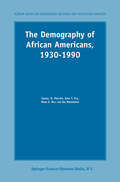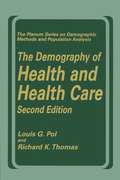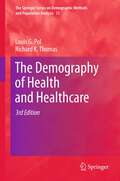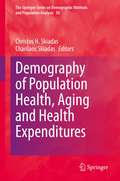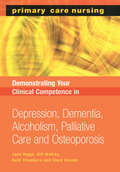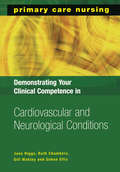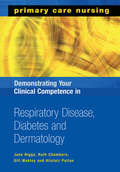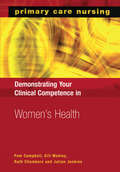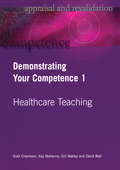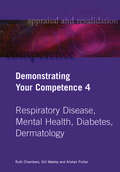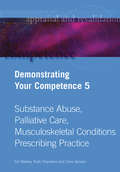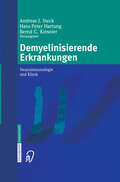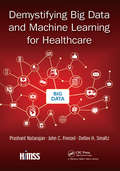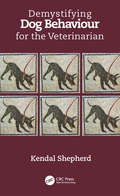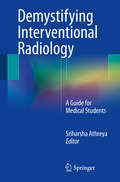- Table View
- List View
The Demography of African Americans 1930–1990 (The Springer Series on Demographic Methods and Population Analysis)
by S.H. Preston I.T. Elo Mark E. Hill Ira RosenwaikeThe authors of this work use a novel strategy that combines record linkage and demographic/statistical analysis to produce an internally consistent and robust set of estimates of the African-American population during the period 1930-1990. They interpret the record that emerges, with special reference to longevity trends and differentials. This work is for demographers, sociologists and students of ethnic studies.
The Demography of Health and Health Care (The Springer Series on Demographic Methods and Population Analysis)
by Louis G. Pol Richard K. ThomasThis is a thoroughgoing revision of the first edition of this classic text and reference, published by Plenum in 1992. The authors convey the general principles that underlie this applied subdiscipline and demonstrate how the merging of demography and health care impacts on the planning processes of a range of health care organizations.
The Demography of Health and Healthcare (The Springer Series on Demographic Methods and Population Analysis #13)
by Louis G. Pol Richard K. ThomasIn this 3rd edition of the definitive work on health demography, Pol and Thomas offer an updated view of the field and a current perspective on the applications of health demography to contemporary issues. The significance of health demography within the field of population studies has continued to increase and this work provides background on the healthcare arena and systematically presents the various aspects of demography as they relate to healthcare. This addition has been streamlined to focus on the important aspects of health demography and enhanced through the addition of charts, maps and other graphics. All statistics and tables have been updated and the most current references are included. A separate chapter on morbidity has been included and the final chapter focuses on the public policy interface with health demography. Case studies and sidebars are included throughout the book to illustrate the applications of demography within the healthcare arena. Recent developments in U.S. healthcare are highlighted to give the text a very contemporary presence.
Demography of Population Health, Aging and Health Expenditures (The Springer Series on Demographic Methods and Population Analysis #50)
by Christos H. Skiadas Charilaos SkiadasThis book provides theoretical and applied material for estimating vital parts of demography and health issues including the healthy aging process along with calculating the healthy life years lost to disability. It further includes the appropriate methodology for the optimum health expenditure allocation. Through providing data analysis, statistical and stochastic methodology, probability approach and important applications, the book explores topics such as aging and mortality, birth-death processes, self-perceived age, life-time and survival as well as pension and labor-force. By providing a methodological approach to health problems in demography and society including and quantifying important parameters, this book is a valuable guide for researchers, theoreticians and practitioners from various disciplines.
Demons: Our changing attitudes to alcohol, tobacco, and drugs
by Virginia BerridgeTabloid headlines attack the binge drinking of young women. Debates about the classification of cannabis continue, while major public health campaigns seek to reduce and ultimately eliminate smoking through health warnings and legislation. But the history of public health is not a simple one of changing attitudes resulting from increased medical knowledge, though that has played a key role, for instance since the identification of the link between smoking and lung cancer. As Virginia Berridge shows in this fascinating exploration, attitudes to public health, and efforts to change it, have historically been driven by social, cultural, political, and economic and industrial factors, as well as advances in science. They have resulted in different responses to drugs, alcohol, and tobacco at different times, in different parts of the world. Opium dens in London, temperance and prohibition movements, the appearance of new recreational drugs in the 20th century, the changing attitudes to smoking: by taking us through such examples, moulded by socio-economic and political forces, including the growing power of pharmaceutical companies, Berridge illuminates current debates. While our medical knowledge has advanced, other factors help shape our responses, as they have done in the past.
Demonstrating Your Clinical Competence: Depression, Dementia, Alcoholism, Palliative Care and Osteoperosis
by Jane Higgs Gill Wakley Ruth Chambers Clare GeradaThis work is intended for those already in working in community care, including nurses, nursing students and social workers. It is aimed at those who have to provide palliative care from time to time, and at those who are considering a career shift into this field.
Demonstrating Your Clinical Competence: Depression, Dementia, Alcoholism, Palliative Care and Osteoperosis
by Jane Higgs Gill Wakley Ruth Chambers Clare GeradaThis work is intended for those already in working in community care, including nurses, nursing students and social workers. It is aimed at those who have to provide palliative care from time to time, and at those who are considering a career shift into this field.
Demonstrating Your Clinical Competence in Cardiovascular and Neurological Conditions
by Jane Higgs Ruth Chambers Gill Wakley Simon EllisAll registered nurses are required to keep portfolios which demonstrate their competence in clinical practice in order to receive re-registration with the Nursing and Midwifery Council. In addition, they are encouraged to seek individual annual appraisals which highlight their progress and areas the require development. This book provides examples and ideas on how to document learning, competence, performance or standards of service delivery. It takes an important clinical theme throughout, providing key information on clinical management from the outset, followed by structured examples of evidence of performance and application of learning in practice, individualised for each clinical theme, focussing on cardiovascular and neurological conditions. It explains how to gather evidence from clinical interactions and other aspects of daily work. All nurses working in primary care with an interest in chronic disease management, especially those who are looking for a more ‘first contact’ work within their role will find this book valuable reading.
Demonstrating Your Clinical Competence in Cardiovascular and Neurological Conditions
by Jane Higgs Ruth Chambers Gill Wakley Simon EllisAll registered nurses are required to keep portfolios which demonstrate their competence in clinical practice in order to receive re-registration with the Nursing and Midwifery Council. In addition, they are encouraged to seek individual annual appraisals which highlight their progress and areas the require development. This book provides examples and ideas on how to document learning, competence, performance or standards of service delivery. It takes an important clinical theme throughout, providing key information on clinical management from the outset, followed by structured examples of evidence of performance and application of learning in practice, individualised for each clinical theme, focussing on cardiovascular and neurological conditions. It explains how to gather evidence from clinical interactions and other aspects of daily work. All nurses working in primary care with an interest in chronic disease management, especially those who are looking for a more ‘first contact’ work within their role will find this book valuable reading.
Demonstrating Your Clinical Competence in Respiratory Disease, Diabetes and Dermatology
by Jane Higgs Ruth Chambers Gill Wakley Alistair PullanEvidence-based medicine draws on terminology used in biostatistics epidemiology health economics philosophy ethics logic and the social sciences. In this unique compendium the author defines the common terms used in evidence-based medicine and provides useful notes and references to help the reader understand this terminology and explore further if necessary. The book explains statistical formulae commonly used in evidence-based medicine. It is ideal for doctors nurses and pharmacists who are not familiar with statistical terms and statisticians and health economists who are not familiar with pharmaceutical or clinical terminology. The definitions explanatory notes and references are clear and easily understandable.
Demonstrating Your Clinical Competence in Respiratory Disease, Diabetes and Dermatology
by Jane Higgs Ruth Chambers Gill Wakley Alistair PullanEvidence-based medicine draws on terminology used in biostatistics epidemiology health economics philosophy ethics logic and the social sciences. In this unique compendium the author defines the common terms used in evidence-based medicine and provides useful notes and references to help the reader understand this terminology and explore further if necessary. The book explains statistical formulae commonly used in evidence-based medicine. It is ideal for doctors nurses and pharmacists who are not familiar with statistical terms and statisticians and health economists who are not familiar with pharmaceutical or clinical terminology. The definitions explanatory notes and references are clear and easily understandable.
Demonstrating Your Clinical Competence in Women's Health
by Pam Campbell Gill Wakley Ruth Chambers Julian JenkinsPrimary Care Nursing Series. All registered nurses are required to keep portfolios which demonstrate their competence in clinical practice in order to receive re-registration with the Nursing and Midwifery Council. In addition, they are encouraged to seek individual annual appraisals which highlight their progress and areas the require development. This book provides examples and ideas on how to document learning, competence, performance or standards of service delivery. Presented in an easy-to-read style, with practical suggestions to improve clinical care, it enables readers to expand their clinical knowledge as well as enabling them to demonstrate their level of expertise through portfolio work, focusing on the area of women’s health. It highlights the most appropriate evidence to prove competency and expertise, and provides the information to identify areas of strength and weakness, suggesting ways in which clinical care can be improved and explains how to gather evidence for clinical interactions and other aspects of daily work. All nurses working in primary care with an interest in women’s health, including practice nurses, health visitors, community midwives, school nurses, district nurses, occupational health nurses and sexual health nurses will find this book essential reading. For more information on other titles in this series please click here
Demonstrating Your Clinical Competence in Women's Health
by Pam Campbell Gill Wakley Ruth Chambers Julian JenkinsPrimary Care Nursing Series. All registered nurses are required to keep portfolios which demonstrate their competence in clinical practice in order to receive re-registration with the Nursing and Midwifery Council. In addition, they are encouraged to seek individual annual appraisals which highlight their progress and areas the require development. This book provides examples and ideas on how to document learning, competence, performance or standards of service delivery. Presented in an easy-to-read style, with practical suggestions to improve clinical care, it enables readers to expand their clinical knowledge as well as enabling them to demonstrate their level of expertise through portfolio work, focusing on the area of women’s health. It highlights the most appropriate evidence to prove competency and expertise, and provides the information to identify areas of strength and weakness, suggesting ways in which clinical care can be improved and explains how to gather evidence for clinical interactions and other aspects of daily work. All nurses working in primary care with an interest in women’s health, including practice nurses, health visitors, community midwives, school nurses, district nurses, occupational health nurses and sexual health nurses will find this book essential reading. For more information on other titles in this series please click here
Demonstrating Your Competence: v. 1
by Ruth Chambers Kay Mohanna Gill Wakley David WallThis working manual has been developed to ensure that all health professionals involved in immunization will be both knowledgable about procedures and confident about their benefits. It shows the practitioner how to give vaccines safely and how to inform parents. The book is line with the new and revised "Immunization Against Infectious Disease" produced by the Department of Health, but is written in a practical and easily accessible form. As well as being aimed at general practitioners, health visitors, school health nurses, practice nurses, clinical medical officers and district nurses, the book has been written in such a fashion as to be understandable by parents. It has sections giving answers to the questions most frequently asked by parents, and to the most common problems. In addition, the book is adaptable for local use, with space for key contacts and `phone numbers.
Demonstrating Your Competence: v. 1
by Ruth Chambers Kay Mohanna Gill Wakley David WallThis working manual has been developed to ensure that all health professionals involved in immunization will be both knowledgable about procedures and confident about their benefits. It shows the practitioner how to give vaccines safely and how to inform parents. The book is line with the new and revised "Immunization Against Infectious Disease" produced by the Department of Health, but is written in a practical and easily accessible form. As well as being aimed at general practitioners, health visitors, school health nurses, practice nurses, clinical medical officers and district nurses, the book has been written in such a fashion as to be understandable by parents. It has sections giving answers to the questions most frequently asked by parents, and to the most common problems. In addition, the book is adaptable for local use, with space for key contacts and `phone numbers.
Demonstrating Your Competence: v. 4
by Ruth Chambers Gill Wakley Alistair PullanThis volume, focusing on breast cancer, is part of a survey of health care needs for specific conditions, published on behalf of the Department of Health. This study overall considers questions such as the population's needs, the services available or unavailable to them, the effectiveness of these services, and other perspectives in disease and service areas. This is the second series of needs assessment reviews.
Demonstrating Your Competence: v. 4
by Ruth Chambers Gill Wakley Alistair PullanThis volume, focusing on breast cancer, is part of a survey of health care needs for specific conditions, published on behalf of the Department of Health. This study overall considers questions such as the population's needs, the services available or unavailable to them, the effectiveness of these services, and other perspectives in disease and service areas. This is the second series of needs assessment reviews.
Demonstrating Your Competence: v. 5
by Gill Wakley Ruth Chambers Clare GeradaThis volume, focusing on dermatology, is part of a survey of health care needs for specific conditions, published on behalf of the Department of Health. This study overall considers questions such as the population's needs, the services available or unavailable to them, the effectiveness of these services, and other perspectives in disease and service areas. This is the second series of needs assessment reviews.
Demonstrating Your Competence: v. 5
by Gill Wakley Ruth Chambers Clare GeradaThis volume, focusing on dermatology, is part of a survey of health care needs for specific conditions, published on behalf of the Department of Health. This study overall considers questions such as the population's needs, the services available or unavailable to them, the effectiveness of these services, and other perspectives in disease and service areas. This is the second series of needs assessment reviews.
Demyelinisierende Erkrankungen: Neuroimmunologie und Klinik
by Andreas J. Steck U. Schuler Hans-Peter Hartung Bernd C. KieseierDemystifying Big Data and Machine Learning for Healthcare
by Prashant Natarajan John C. Frenzel Detlev H. SmaltzHealthcare transformation requires us to continually look at new and better ways to manage insights – both within and outside the organization today. Increasingly, the ability to glean and operationalize new insights efficiently as a byproduct of an organization’s day-to-day operations is becoming vital to hospitals and health systems ability to survive and prosper. One of the long-standing challenges in healthcare informatics has been the ability to deal with the sheer variety and volume of disparate healthcare data and the increasing need to derive veracity and value out of it. Demystifying Big Data and Machine Learning for Healthcare investigates how healthcare organizations can leverage this tapestry of big data to discover new business value, use cases, and knowledge as well as how big data can be woven into pre-existing business intelligence and analytics efforts. This book focuses on teaching you how to: Develop skills needed to identify and demolish big-data myths Become an expert in separating hype from reality Understand the V’s that matter in healthcare and why Harmonize the 4 C’s across little and big data Choose data fi delity over data quality Learn how to apply the NRF Framework Master applied machine learning for healthcare Conduct a guided tour of learning algorithms Recognize and be prepared for the future of artificial intelligence in healthcare via best practices, feedback loops, and contextually intelligent agents (CIAs) The variety of data in healthcare spans multiple business workflows, formats (structured, un-, and semi-structured), integration at point of care/need, and integration with existing knowledge. In order to deal with these realities, the authors propose new approaches to creating a knowledge-driven learning organization-based on new and existing strategies, methods and technologies. This book will address the long-standing challenges in healthcare informatics and provide pragmatic recommendations on how to deal with them.
Demystifying Big Data and Machine Learning for Healthcare
by Prashant Natarajan John C. Frenzel Detlev H. SmaltzHealthcare transformation requires us to continually look at new and better ways to manage insights – both within and outside the organization today. Increasingly, the ability to glean and operationalize new insights efficiently as a byproduct of an organization’s day-to-day operations is becoming vital to hospitals and health systems ability to survive and prosper. One of the long-standing challenges in healthcare informatics has been the ability to deal with the sheer variety and volume of disparate healthcare data and the increasing need to derive veracity and value out of it. Demystifying Big Data and Machine Learning for Healthcare investigates how healthcare organizations can leverage this tapestry of big data to discover new business value, use cases, and knowledge as well as how big data can be woven into pre-existing business intelligence and analytics efforts. This book focuses on teaching you how to: Develop skills needed to identify and demolish big-data myths Become an expert in separating hype from reality Understand the V’s that matter in healthcare and why Harmonize the 4 C’s across little and big data Choose data fi delity over data quality Learn how to apply the NRF Framework Master applied machine learning for healthcare Conduct a guided tour of learning algorithms Recognize and be prepared for the future of artificial intelligence in healthcare via best practices, feedback loops, and contextually intelligent agents (CIAs) The variety of data in healthcare spans multiple business workflows, formats (structured, un-, and semi-structured), integration at point of care/need, and integration with existing knowledge. In order to deal with these realities, the authors propose new approaches to creating a knowledge-driven learning organization-based on new and existing strategies, methods and technologies. This book will address the long-standing challenges in healthcare informatics and provide pragmatic recommendations on how to deal with them.
Demystifying Dog Behaviour for the Veterinarian
by Kendal ShepherdThe behaviour textbook that's been missing! - Dr Mandy Roshier, University of Nottingham, School of Veterinary Medicine and Science, UK This practical guide for busy veterinarians demystifies the apparently complex nature of canine behaviour while simultaneously emphasising its importance. Authored by acclaimed veterinary behaviour consultant Kendal Shepherd, the book provides practical knowledge of dog behaviour and an understanding of how to talk about it with clients. Shepherd shows how this can enhance the relationship between owner and pet and between dog and environment, including the vet surgery, as well as improve the vet’s own sense of fulfilment and enjoyment of practice. From a discussion on the true nature of obedience to stressing the importance of behavioural indicators when assessing pain and mental welfare and finally by reminding vets of their obligations under Dangerous Dogs legislation, the emphasis is on the prevention of aggression throughout. Packed with anecdotes drawn from real-life cases, easy to read and understand, the principles explained can be effortlessly assimilated into the average consultation without the need for lengthy report-writing.
Demystifying Dog Behaviour for the Veterinarian
by Kendal ShepherdThe behaviour textbook that's been missing! - Dr Mandy Roshier, University of Nottingham, School of Veterinary Medicine and Science, UK This practical guide for busy veterinarians demystifies the apparently complex nature of canine behaviour while simultaneously emphasising its importance. Authored by acclaimed veterinary behaviour consultant Kendal Shepherd, the book provides practical knowledge of dog behaviour and an understanding of how to talk about it with clients. Shepherd shows how this can enhance the relationship between owner and pet and between dog and environment, including the vet surgery, as well as improve the vet’s own sense of fulfilment and enjoyment of practice. From a discussion on the true nature of obedience to stressing the importance of behavioural indicators when assessing pain and mental welfare and finally by reminding vets of their obligations under Dangerous Dogs legislation, the emphasis is on the prevention of aggression throughout. Packed with anecdotes drawn from real-life cases, easy to read and understand, the principles explained can be effortlessly assimilated into the average consultation without the need for lengthy report-writing.
Demystifying Interventional Radiology: A Guide for Medical Students
by Sriharsha AthreyaThis book is a concise introduction to the interventional radiology field and is designed to help medical students and residents understand the fundamental concepts related to image-guided interventional procedures and determine the appropriate use of imaging modalities in the treatment of various disorders. It covers the history of interventional radiology; radiation safety; equipment; medications; and techniques such as biopsy and drainage, vascular access, embolization, and tumor ablation. The book also describes the indications, patient preparation, post-procedure care, and complications for the most common interventional radiology procedures.
